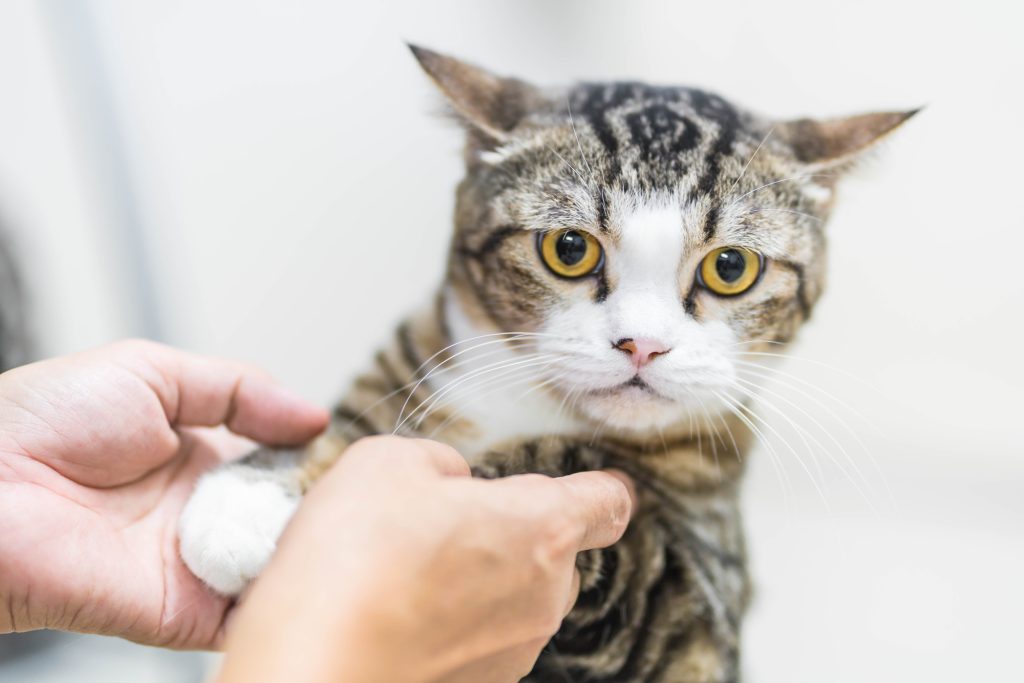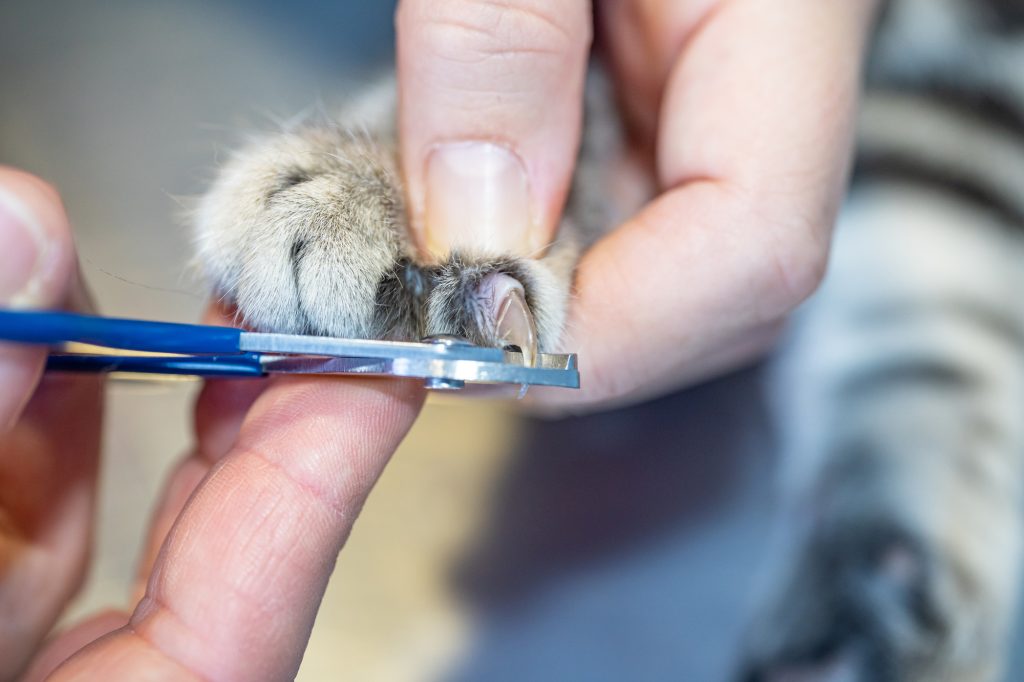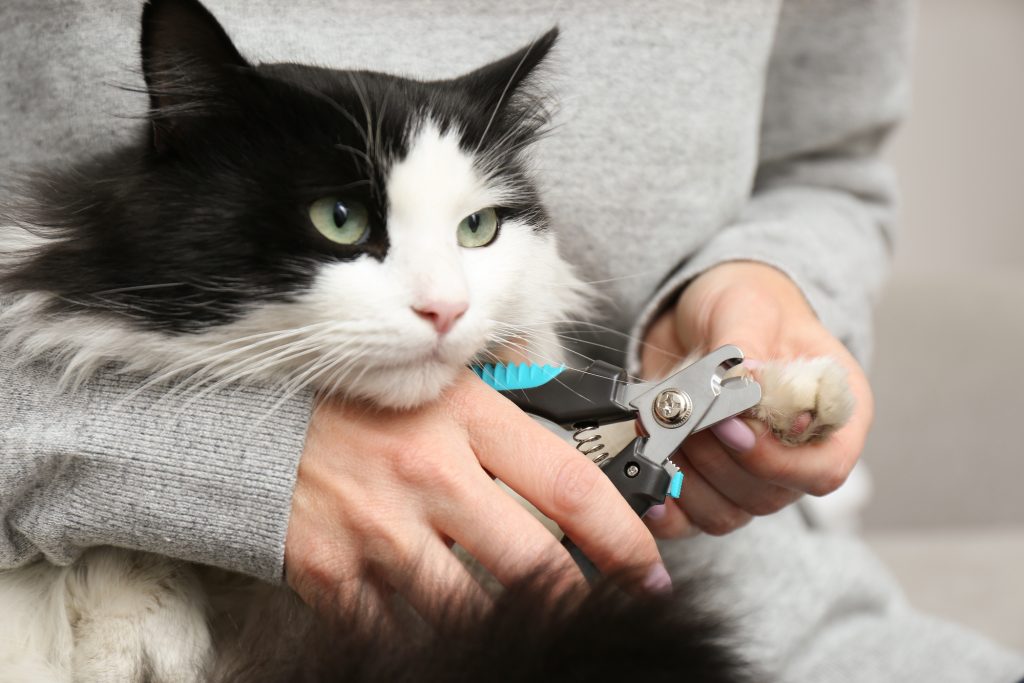Table of Contents
Clipping a cat’s nails can be daunting, but it’s an essential part of pet care to prevent overgrown nails. To successfully trim a cat’s nails, you need the right tools and techniques. Start by cradling your cat in the crook of your arm and gently squeeze the paw in your hand to expose the claws. Use specialized clippers for cats, and make sure your cat’s nails are trimmed with precision and care. Remember to keep the nail trimmers perpendicular to the nail to avoid splintering.
For many cats, trimming their nails can be a stressful experience. To make it easier, hold your feline friend securely and offer reassurance. Gently press each paw to expose the claws before you trim their nails. After each successful clip, reward your cat for their patience, reinforcing a positive association with nail trimming.
Preparing for the Nail-Trimming Session
Before you trim their nails, ensure you have the appropriate nail trimmers and that your cat is relaxed. Creating a calm environment will make the process smoother for both of you.
Types of Nail Clippers: Pros and Cons
Choosing the right tool is crucial for a safe and efficient nail-trimming session. Each type of nail clipper has its advantages and is suitable for cats with different nail thicknesses.
• Scissor-Style Nail Clippers
Scissor-style nail clippers are akin to a pair of scissors, offering control and precision. They are ideal for cats with thinner nails. Unlike human nail clippers, they are designed to contour to the natural shape of your cat’s nails, ensuring a clean cut without splintering.
• Plier-Style Nail Clippers
Plier-style nail clippers are well-suited for cats with thicker nails. Their design allows for a firm grip and greater leverage, which can make it easier to clip through the tough nail with less force, reducing the risk of nail cracking.
• Nail Grinders
Nail grinders offer a gentle alternative to clippers by grinding down the nail rather than cutting. They can be ideal for cats who are resistant to traditional clippers, as they create a smooth, rounded nail edge.
• Nail Scissors
Nail scissors are small and precise, making them an excellent choice for kittens or cats with small, delicate nails. Their design allows for close trimming, minimizing the risk of cutting too far into the quick.
• Guillotine-Style Nail Clippers
Guillotine-style nail clippers have a stationary ring where the nail is placed before cutting. They can be easy to use, but it is essential to replace the blade regularly to ensure a clean cut and prevent nail splitting.
Creating a Calm and Serene Environment
To make nail trimming a stress-free experience, it’s essential to create a tranquil space for your feline. Begin by selecting a quiet room, one familiar to your cat, where hustle and bustle won’t distract or frighten them. Soft, soothing music can help set a peaceful mood, and a comfortable seating area where you can hold and trim their nails with ease will ensure both you and your kitty stay relaxed. Keep their favorite blanket nearby to provide additional comfort and a sense of security during the trimming process.

Understanding Your Cat’s Nails
The Anatomy of a Cat’s Claw
Each of your cat’s claws is a marvel of nature, designed for climbing, hunting, and self-defense. The claw is made up of several parts: the sharp tip for catching prey, the barb-like underside to maintain grip, and the quick, which houses nerves and blood vessels. The quick is sensitive and, if cut, can bleed and cause pain, so be cautious to trim only the clear, non-sensitive part of the nail.
Understanding this anatomy is fundamental when preparing to clip your cat’s nails. The outer sheath of the claw is what you’ll be trimming, and it’s important to avoid the quick to prevent discomfort. Regular inspection of your cat’s nails will familiarize you with their anatomy, making the trimming process easier for both of you.
Signs That It’s Time to Trim
Knowing when to trim your cat’s nails is key to their well-being. If you hear clicking sounds when they walk on hard surfaces or see them getting stuck in carpets or blankets, it’s time for a trim. In addition, look for nails that appear visibly long or are curling under – these are sure signs that a trim is overdue. Pay extra attention to older cats, as they are less active and wear down their nails less through natural scratching, leading to more frequent trims.
Step-By-Step Guide to Trimming Cat Nails
Ready to begin? Gather your supplies, including cat treats, and settle your cat in your lap. If you’re using a nail grinder, ensure it is charged and ready. Check that your cat’s nails need trimming, not forgetting the dew claws, which can sometimes be overlooked.
Step 1: Introduce Your Cat to the Clippers
Before you start the actual trimming, let your cat become acquainted with the clippers. Allow them to sniff and inspect the tool so it won’t be a surprise during the trimming. Gently touch their paws with the clippers closed to get them used to the sensation of the tool against their skin.
Step 2: Position Your Cat Comfortably
Hold your cat in the crook of your arm or in your lap, whichever is most comfortable for both of you. Speak to them in a soft, reassuring tone to maintain a serene environment. It’s important that your cat feels secure and not restrained, so use gentle but firm holds when positioning their paws for trimming.
Step 3: Gently Press the Paw to Expose the Nail
When you’re ready to start trimming, gently press on your cat’s paw pad to extend the claws. This is a step that may take some training your cat to become accustomed to. Be patient, and reward them for allowing you to handle their paws. This will make the process easier over time.
Step 4: Trim Nails at a Safe Angle
As you trim your cat’s nails, maintain a 45-degree angle to avoid the quick. If your cat is one of the older cats, they might need a bit more reassurance during this process. Be sure to trim the tip, taking small portions of the nail at a time. Hold their paw firmly but gently with your non-dominant hand, and use your dominant hand to trim. After trimming your cat’s nails, give them a treat, and limit the session to about 5 minutes to keep the experience positive.
How Much to Clip: Avoiding the Quick
Many cats have clear nails, making it easier to see quickly and avoid it. Aim to clip just the white part of the nail, well away from the pinkish area where the quick starts. If the nails aren’t clear, err on the side of caution and trim less rather than more.
Step 5: Reward Your Cat for Their Patience
After having their claws clipped, it’s important to show appreciation for your cat’s cooperation. If your cat is calm, offer them a special cat treat as a thank you. This positive reinforcement can make future nail-trimming sessions easier. You might also gently massage their paws to associate the experience with relaxation and comfort, solidifying the positive association.

Post-Trimming Care and Observation
Monitoring Your Cat After Trimming
Once the nail trimming is complete, watch your cat to ensure they are walking normally and there are no signs of discomfort. If they seem to be licking their paws excessively or favoring a paw, it may be necessary to inspect for any issues that might have arisen during the nail-trimming process.
What to Do if You Accidentally Clip the Quick
If you accidentally trim your cat’s claw too short and nick the quick, causing bleeding, press some flour or cornstarch onto the nail to help stop the bleeding. Many pet supply stores also carry kwik-stop styptic powder, a specialized product where styptic powder stops bleeding quickly. Keep calm to help reassure your cat.
What to Do with Uncooperative Cats
Handling uncooperative cats during nail trimming can be challenging. If they are resistant, pause the process and try again later. It’s essential to avoid stress and injury by not forcing the trimming if your cat is highly agitated or fearful.
Desensitizing Your Cat to Nail Clipping
Teaching your cat to tolerate nail clipping involves patience and gradual exposure. Start by gently squeezing their paws regularly to get them used to the sensation. Having styptic powder on hand will prepare you in case you accidentally trim the nail too short. Remember, health issues can make cats more sensitive, so always handle their paws with care.

Frequently Asked Questions
1. Do cat’s claws hurt if they are too long?
Yes, if a cat’s claws become too long, they can curl into the paw pads, causing pain and potential infections. It’s crucial to maintain a regular trimming schedule to prevent such discomfort.
2. How often should I clip cat nails?
The frequency of nail trimming can depend on your cat’s lifestyle, but generally, it’s recommended to check their claws every couple of weeks. Blood vessels and nerves grow with the nail, so regular trims help avoid discomfort. If you’re unsure, hold your cat’s paws in your hand and inspect the length.
3. Can I use human nail clippers on my cat?
While it’s possible, human nail clippers are not designed for the curved shape of a cat’s claws and can cause splitting or fraying. It’s better to use specialized pet clippers to encourage your cat to remain calm and make the process smoother. Always handle your cat’s paws and gently clip them with care.
4. Do scratching posts trim cats’ nails?
Scratching posts don’t trim a cat’s nails, but they do help maintain claw health. By scratching, cats shed the outer nail layer, keeping the claws sharp. While it’s a natural behavior that supports their well-being, it’s not a substitute for cutting their nails. Encourage your cat to use a scratching post regularly to complement nail trimming.
Wrapping Up
As we conclude this guide on how to trim my cat’s nails, remember that maintaining your cat’s claw health is a crucial aspect of their well-being. Regular nail trims prevent the sharp tips from becoming overgrown and causing discomfort. However, always ensure the nail clippers are sharp; dull blades can cause the claw to extend improperly or even split, potentially reaching the sensitive nerve endings. Trimming at a 45-degree angle helps avoid this, promoting a quick and clean cut.

Hi, I’m Zoey, a devoted mom to two charming Siamese cats. My passion lies in assisting fellow pet owners in providing optimal care for their cats. On CatsEuphoria, I share practical tips and relatable stories, inviting you to join me in appreciating the authentic bond between humans and our beloved feline companions.




